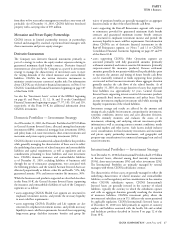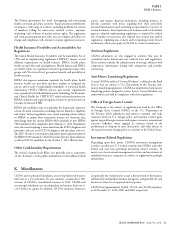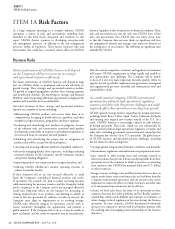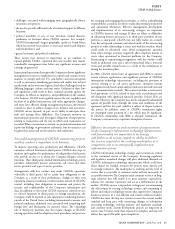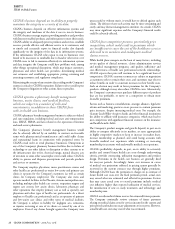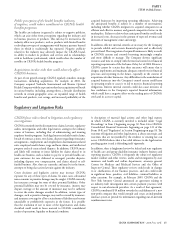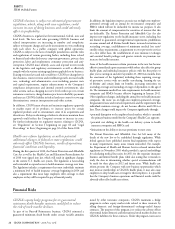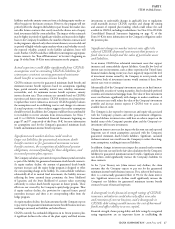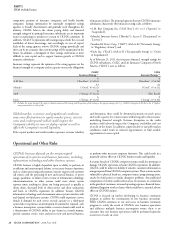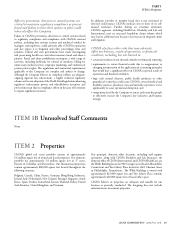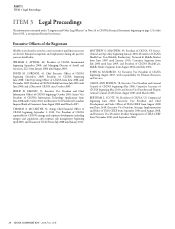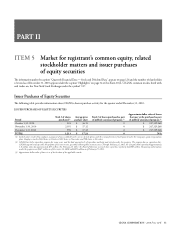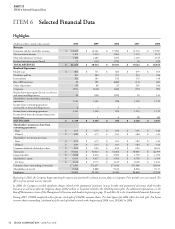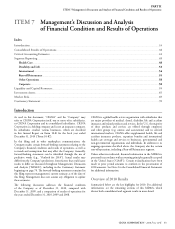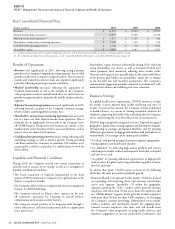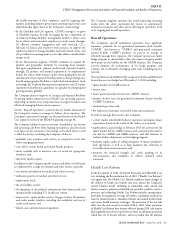Cigna 2010 Annual Report Download - page 46
Download and view the complete annual report
Please find page 46 of the 2010 Cigna annual report below. You can navigate through the pages in the report by either clicking on the pages listed below, or by using the keyword search tool below to find specific information within the annual report.
CIGNA CORPORATION 2010 Form 10K
26
PARTI
ITEM 1A Risk Factors
CIGNA’s business is subject to substantial government
regulation, which, along with new regulation, could
increase its costs of doing business and could adversely
aff ect its profi tability.
CIGNA’s business is regulated at the international, federal, state and
local levels. e laws and rules governing CIGNA’s business and
related interpretations are increasing in number and complexity,
subject to frequent change and can be inconsistent or even confl icting
with each other. As a public company with global operations,
CIGNA is subject to the laws of multiple jurisdictions and the rules
and regulations of various governing bodies, including those related
to fi nancial and other disclosures, corporate governance, privacy, data
protection, labor and employment, consumer protection and anti-
corruption. CIGNA must identify, assess and respond to new trends
in the legislative and regulatory environments as well as eff ectively
comply with the various existing regulations applicable to its business.
Existing or future laws and rules could force CIGNA to change how it
does business, restrict revenue and enrollment growth, increase health
care, technology and administrative costs including pension costs
and capital requirements, require enhancements to the Company’s
compliance infrastructure and internal controls environment, take
other actions such as changing its reserve levels with respect to certain
reinsurance contracts, change business practices in disability payments
and increase CIGNA’s liability in federal and state courts for coverage
determinations, contract interpretation and other actions.
In addition, CIGNA must obtain and maintain regulatory approvals
to market many of its products, to increase prices for certain
regulated products and to consummate some of its acquisitions and
divestitures. Delays in obtaining or failure to obtain or maintain these
approvals could reduce the Company’s revenue or increase its costs.
For further information on regulatory matters relating to CIGNA,
see “Regulation” in Section J beginning on page 18 and “Legal
Proceedings” in Item 3 beginning on page 30 of this Form 10-K.
Health care reform legislation, as well as potential
additional changes in federal or state regulations could
adversely aff ect CIGNA’s business, results of operations,
fi nancial condition and liquidity.
During the fi rst quarter of 2010, the Patient Protection and Aff ordable
Care Act as well as the Health Care and Education Reconciliation Act
of 2010 were signed into law, which will result in signifi cant changes
to the current U.S. health care system. e legislation is far-reaching
and is intended to expand access to health insurance coverage over time.
e legislation includes a requirement that most individuals maintain
a minimum level of health insurance coverage beginning in 2014 and
also a requirement that most large employers off er coverage to their
employees or they will be required to pay a fi nancial penalty.
In addition, the legislation imposes an excise tax on high-cost employer-
sponsored coverage and an annual fee on insurance companies and
HMOs which will not be deductible for income tax purposes. It also
limits the amount of compensation for executives of insurers that this
tax deductible. e Patient Protection and Aff ordable Care Act also
imposes new regulations on the health insurance sector, including, but
not limited to, guaranteed coverage/renewal requirements, prohibitions
on some annual and all lifetime benefi t limits, increased restrictions on
rescinding coverage, establishment of minimum medical loss ratio/
enrollee rebate requirements, a requirement to cover preventive services
on a fi rst dollar basis, the establishment of state insurance exchanges
and essential benefi t packages and greater controls on premium rate
increases for health insurance.
Some of the health insurance reform provisions in the new law became
eff ective immediately upon enactment while others take eff ect for group
health plans and individual insurance policies with the fi rst policy or
plan year occurring on and after September 23, 2010 (six months from
the enactment of the legislation) including those requiring coverage
of preventive services with no enrollee cost-sharing, banning the use
of lifetime and certain limits on benefi ts, increasing restrictions on
rescinding coverage and extending coverage of dependents to the age of
26. e minimum medical loss ratio requirements for health insurance
companies and HMOs became eff ective beginning in January 2011.
Other signifi cant changes, including the annual fees on health insurance
companies, the excise tax on high-cost employer-sponsored coverage,
the guaranteed issue and renewal requirements and the requirement that
individuals maintain coverage, do not become eff ective until 2014 or
later. ese changes could impact the Company signifi cantly through:
•potential disruption to the employer based market, which is currently
the primary business model for the Company’s Health Care segment;
•potential cost shifting in the health care delivery system to health
insurance companies and HMOs; and
•limitations on the ability to increase premiums to meet costs.
e Patient Protection and Aff ordable Care Act left many of the
details of the new law to be established through regulations. While
federal agencies have published interim fi nal regulations with respect
to many requirements, many issues remain unresolved. For example,
the Department of Health and Human Services released interim fi nal
regulations in November 2010 which provided a special methodology
for calculating medical loss ratios for 2011 for the expatriate insurance
business and limited benefi t plans while also stating that it intends to
study the data in determining whether special accommodations will
be made for these plans in 2012 and future years. While health care
reform presents the Company with new business opportunities which
may increase membership in CIGNA’s health plans, it may also cause
employers to drop health care coverage for their employees; it is possible
that the Company’s business operations and fi nancial results could be
adversely aff ected by health care reform.
Financial Risks
CIGNA’s equity hedge program for its guaranteed
minimum death benefi ts contracts could fail to reduce
the risk of stock market declines.
As part of its Run-off Reinsurance business, CIGNA reinsured a
guaranteed minimum death benefi t under certain variable annuities
issued by other insurance companies. CIGNA maintains a hedge
program to reduce equity market risks related to these contracts by
selling domestic and foreign-denominated exchange-traded futures
contracts. e purpose of this program is to reduce the adverse eff ects
of potential future domestic and international stock market declines on
CIGNA’s liabilities for these contracts. Under the program, increases in



